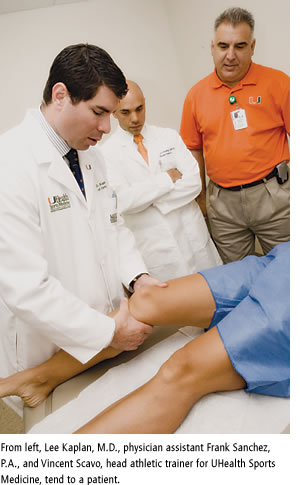Building a Premier Program
For Lee Kaplan, Sports Medicine
is
All About Teamwork
 When Lee Kaplan, M.D., returned to the Miller School in July as the new chief of UHealth Sports Medicine, he was coming back to a familiar playing field. Kaplan not only grew up in South Florida, he did his residency in orthopaedics at the University of Miami/Jackson Memorial Medical Center, followed by a sports medicine fellowship at the University of Pittsburgh. After spending the past six years as assistant professor of orthopaedics and rehabilitation at the University of Wisconsin-Madison School of Medicine, he knows what it takes to get injured athletes back in the game.
When Lee Kaplan, M.D., returned to the Miller School in July as the new chief of UHealth Sports Medicine, he was coming back to a familiar playing field. Kaplan not only grew up in South Florida, he did his residency in orthopaedics at the University of Miami/Jackson Memorial Medical Center, followed by a sports medicine fellowship at the University of Pittsburgh. After spending the past six years as assistant professor of orthopaedics and rehabilitation at the University of Wisconsin-Madison School of Medicine, he knows what it takes to get injured athletes back in the game.
“I was presented with a unique opportunity to return to the Miller School and help build a premier academic-based sports medicine program,” says Kaplan. “At the same time, I get to be close to family in South Florida, so it is clearly a win-win situation.”
With access to top doctors and researchers across a number of departments, being part of the Miller School gives the sports medicine team a competitive edge.
“Sports medicine requires an integrated and comprehensive approach, with professionals across a variety of disciplines working together as a team,” says Kaplan. “This involves everyone from primary care physicians, orthopaedists, surgeons, and neurologists to physical therapists, athletic trainers, and nutritionists. That’s something no one else in South Florida can offer.”
Research is also a critical component, says Kaplan. Along with Alejandro Posada, M.D., assistant professor of orthopaedics, and others, he is actively researching causes and cures for a wide variety of sports-related injuries. Their research is translating into exciting advances in the clinic through improved patient care and on the field through improved training, performance, and injury prevention.
As the official sports medicine provider for the University of Miami Hurricanes, the group works closely with UM’s men’s and women’s teams. Typical injuries seen at the college level include ankle sprains, muscle strains, torn ACLs, rotator cuff syndrome, achilles tendinitis, and plantar fasciitis.
Sports-related medical illnesses will also be a division focus. Asthma, mononucleosis, athletic-induced amenorrhea, and overtraining syndrome are common conditions, according to Kaplan.
“Concussion and post-concussion syndrome are also common,” Kaplan notes, adding that the sports medicine division has a comprehensive Concussion Program led by Gillian Hotz, Ph.D., research associate professor of surgery at the Miller School.
UM’s student-athletes will not be the only ones to benefit from UHealth Sports Medicine. Patients include competitive athletes at all levels—high school, college, and pro—as well as recreational athletes. “Anyone with an injury or medical condition affecting his or her ability to exercise, participate in sports, or maintain an active lifestyle is a candidate for our service,” Kaplan says.
“Because of our climate, people in South Florida seem to be more active and more focused on health and fitness. They can run, bike, swim, golf, play tennis, or do whatever they enjoy doing year-round.” As a result, many patients develop typical wear-and-tear injuries.
“Patients in different age groups tend to present with different types of conditions,” says Kaplan. “But basically, it all comes down to overuse, misuse, or disuse.”